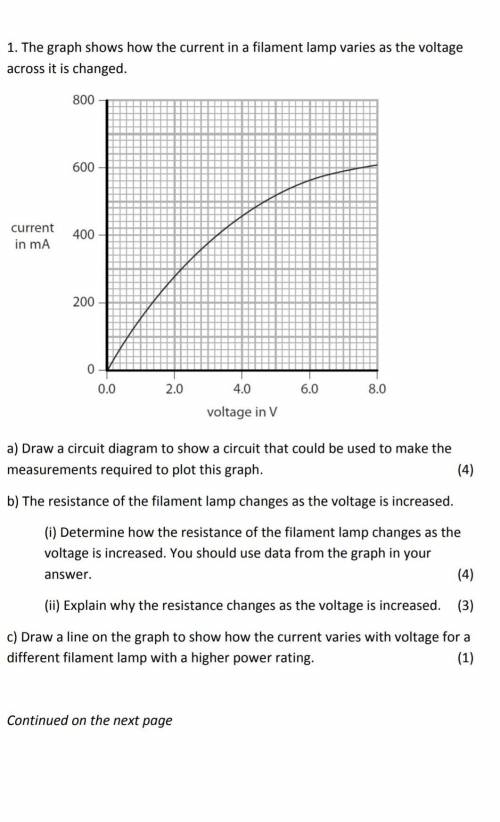
Physics, 07.02.2022 18:50 yourgirlnevaeh
The graph shows how the current in a filament lamp varies as the voltage
across it is changed.
a) Draw a circuit diagram to show a circuit that could be used to make the
measurements required to plot this
graph. (4)
b) The resistance of the filament lamp changes as the voltage is increased.
(i) Determine how the resistance of the filament lamp changes as the
voltage is increased. You should use data from the graph
(ii) Explain why the resistance changes as the voltage is increased.
c) Draw a line on the graph to show how the current varies with voltage for a
different filament lamp with a higher power rating.
CAN SOMEONE PLEASE HELP ME OUT WITH THIS PHYSICS PROBLEM!
GIVE ME THE REAL ANSWER ALREADY! RIGHT NOW!


Answers: 2


Another question on Physics

Physics, 22.06.2019 20:00
Anika asks eva to roll a basketball and then a bowling ball to her. which requires more force to roll, and why?
Answers: 3

Physics, 22.06.2019 20:50
An ideal otto cycle has a compression ratio of 8. at the beginning of the compression process, air is at 95 kpa and 27°c, and 750 kj/kg of heat is transferred to air during the constant-volume heat-addition process. assuming constant specific heats at room temperature, determine (a) the pressure and temperature at the end of the heat-addition process, (b) the net work output, (c) the thermal efficiency, and (d) the mean effective pressure for the cycle. (4390 kpa, 1730 k; 423 kj/kg; 56.4%; 534 kpa)
Answers: 1

Physics, 22.06.2019 22:00
The inside surface of a cylindrical-shaped cave of inner diameter 1.0 m is continuously covered with a very thin layer of water. the cave is very long and it is open on both ends. the water on the cave surface is at a constant temperature of 15.5 °c. the cave is constantly exposed to wind such that 15.5 °c air flows through the cave at 4.5 m/s. the kinematic viscosity of the air is 14.66 x 10-6 m2/s and the molecular diffusion coefficient of water vapor in the air is 0.239 x 10-4 m2/s. because the cave diameter is so large, the flow of wind down the length of the cave, in the x direction, can be treated like it is external flow and the cave surface can be approximated as flat where appropriate. calculate the x value, in a) the transition to turbulent flow occurs at rex meters, where the air flow transitions from laminar to turbulent along the inside surface of the cave b) calculate the x value, in meters, where the bulk steady state concentration of water vapor in the air flowing in the cave is 10% of the saturation concentration. assume the air at the surface of the water layer is 100% saturated with water vapor. assume the wind entering the cave contained no moisture before it entered the cave. take into account the transition from laminar to turbulent flow when solving part b
Answers: 1

Physics, 22.06.2019 22:00
It takes a lot of energy to get the temperature of water to increase and eventually boil because water has a high heat.
Answers: 1
You know the right answer?
The graph shows how the current in a filament lamp varies as the voltage
across it is changed.
Questions

English, 22.06.2019 14:00













Business, 22.06.2019 14:00






Mathematics, 22.06.2019 14:00




